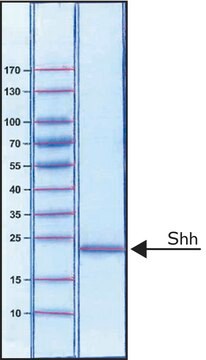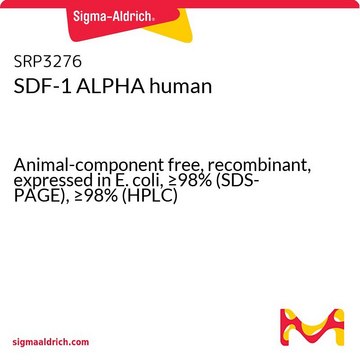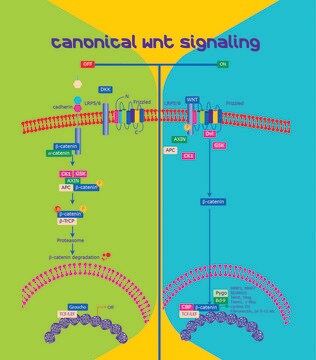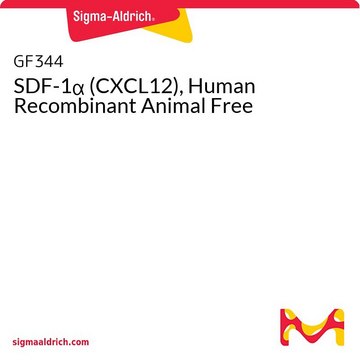GF174
Sonic HedgeHog (Shh) Protein, Human Recombinant
The hedgehog (hh) gene encoding a secreted protein was originally identified in Drosophila as a segment polarity gene.
Synonim(y):
SHH, HHG-1
Zaloguj sięWyświetlanie cen organizacyjnych i kontraktowych
About This Item
Kod UNSPSC:
12352202
eCl@ss:
32160405
NACRES:
NA.77
Polecane produkty
Opis ogólny
Product Source: E. coli.
The hedgehog (hh) gene encoding a secreted protein was originally identified in Drosophila as a segment polarity gene. The vertebrate homologues of hh comprise several proteins including sonic hedgehog (Shh), Indian hedgehog (Ihh), and Desert hedgehog (Dhh). Hedgehog proteins are important signaling molecules during embryonic development. Shh is expressed in key embryonic tissues such as the Hensen’s node, the zone of polarizing activity in the posterior limb bud, the notochord, and the floor plate of the neural tube. Shh is involved in regulating the patterning of the developing central nervous system, somite, and limb. Shh plays an important role in the development of particular tissues such as whisker, hair, foregut, tooth and bone. Evidence also suggests that Shh is involved in regulating stem cell fates of neural and hematopoietic lineages, and that aberrant Shh signaling is implicated in basal cell carcinomas and other diseases. Shh genes are highly conserved and have been identified in a variety of species including human, mouse, frog, fish, and chicken. Recombinant E. coli derived Human Sonic HedgeHog is a 20.0 kDa protein consisting of 176 amino acid residues, including an N-terminal Ile-Val-Ile sequence substituted for the natural occurring chemically modified Cys residue.
Specyficzność
Cross Reactivty
None
None
Zastosowanie
Research Category
Stem Cell Research
Stem Cell Research
Research Sub Category
Growth Factors & Receptors
Growth Factors & Receptors
Jakość
Bioactivity assay: Determined by its ability to induce alkaline phosphatase production by C3H/10T1/2 (CCL-226) cells. The expected ED50 for this effect is 0.8-1.0 μg/ml.
Postać fizyczna
Product is filtered through a 0.2 micron filter before lyophilization.
Przechowywanie i stabilność
Store at -20°C for up to 6 months from date of receipt.
Oświadczenie o zrzeczeniu się odpowiedzialności
Unless otherwise stated in our catalog or other company documentation accompanying the product(s), our products are intended for research use only and are not to be used for any other purpose, which includes but is not limited to, unauthorized commercial uses, in vitro diagnostic uses, ex vivo or in vivo therapeutic uses or any type of consumption or application to humans or animals.
Ta strona może zawierać tekst przetłumaczony maszynowo.
Kod klasy składowania
11 - Combustible Solids
Klasa zagrożenia wodnego (WGK)
WGK 1
Temperatura zapłonu (°F)
Not applicable
Temperatura zapłonu (°C)
Not applicable
Certyfikaty analizy (CoA)
Poszukaj Certyfikaty analizy (CoA), wpisując numer partii/serii produktów. Numery serii i partii można znaleźć na etykiecie produktu po słowach „seria” lub „partia”.
Masz już ten produkt?
Dokumenty związane z niedawno zakupionymi produktami zostały zamieszczone w Bibliotece dokumentów.
Thais Basili et al.
International journal of cancer, 147(8), 2253-2264 (2020-05-10)
Hyalinizing trabecular tumors of the thyroid are rare and mostly benign epithelial neoplasms of follicular cell origin, which have recently been shown to be underpinned by the PAX8-GLIS3 fusion gene. In our study, we sought to investigate the potential oncogenic
Nasz zespół naukowców ma doświadczenie we wszystkich obszarach badań, w tym w naukach przyrodniczych, materiałoznawstwie, syntezie chemicznej, chromatografii, analityce i wielu innych dziedzinach.
Skontaktuj się z zespołem ds. pomocy technicznej







